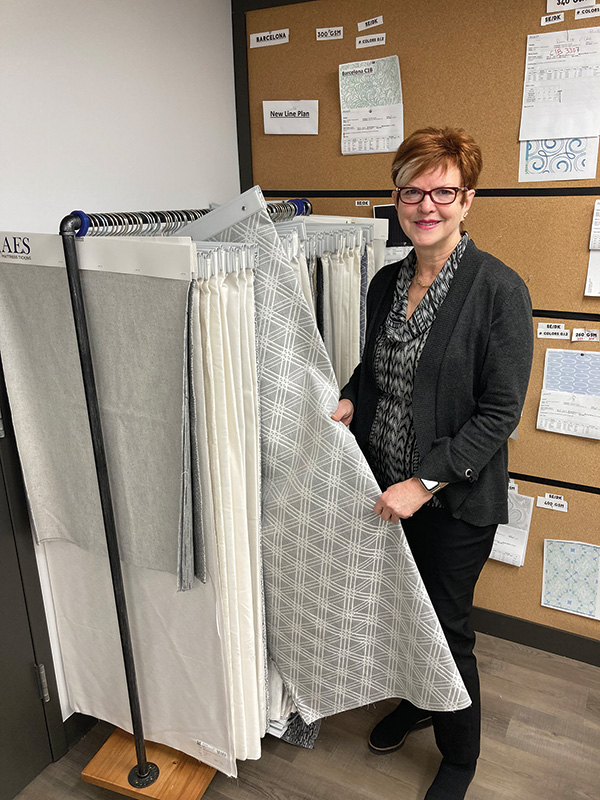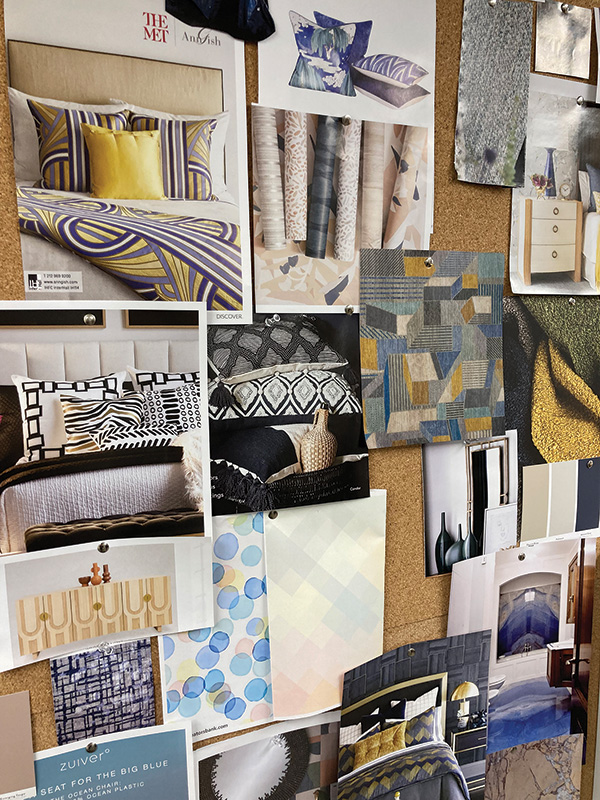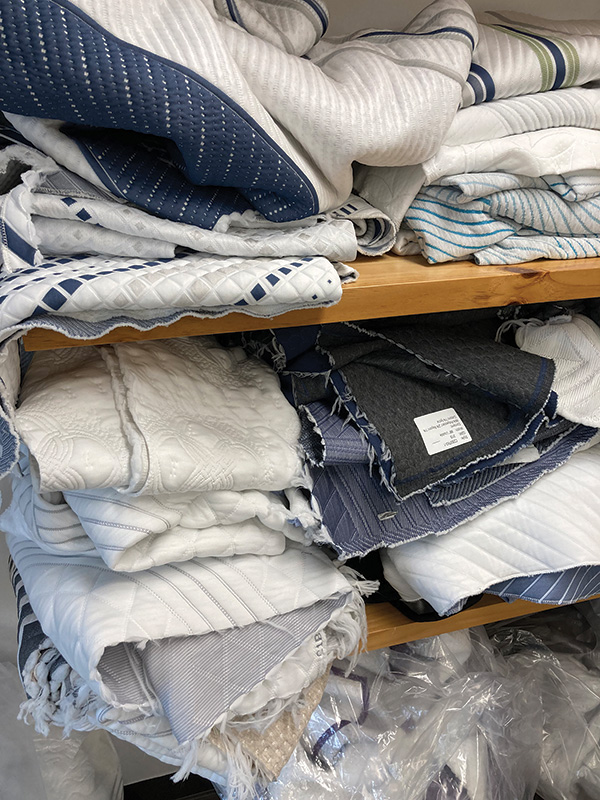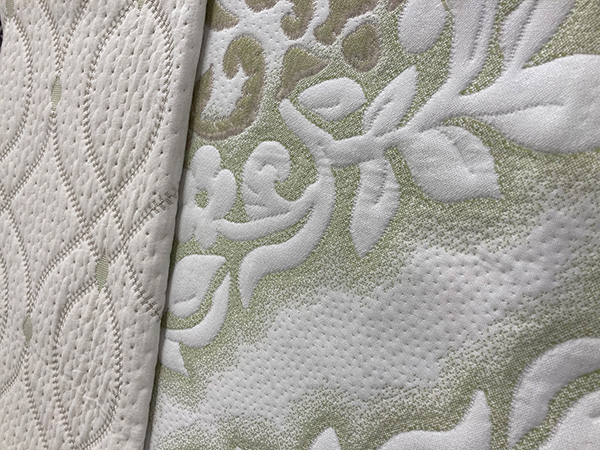A specialty division of Beverly Knits, Creative provides the full package of mattress fabrics.

Another project just landed at Creative — and it’s a fast turn. The directive came in on Friday, and in less than a week’s time, the following Thursday, Creative had already delivered — from design to yarn selection, through knitting and finishing, to a cut-and-sewn product.
No, this isn’t the fast-paced fashion industry with five product drops per year or more.
This is mattress ticking.
Creative Ticking (rebranded as Creative in 2021) was launched by Ron and Janet Sytz in 2006 as the bedding specialty division of Beverly Knits, one of the largest circular knitters in the country based in Gastonia, North Carolina. That company was founded by Ron’s parents, Robert and JoAnn Sytz, in 1980.
Today, Creative designs and produces mattress fabrics and covers that are sought after by mattress makers looking for fashionable materials that can also perform. Think textile technologies — health and wellness, thermoregulation, sustainability and FR materials.
“When we think about the future of the bedding market, we see the incorporation of technologies from textiles used outside of the bedding market,” said Parker Sytz, Ron and JoAnn’s son and director of supply chain management for Creative. “We believe our experience in manufacturing for these other industries uniquely positions us to develop the next generation of fabrics for our customers.”
What does design mean to Creative? The word “design” covers a multitude of topics, from the technical aspect of what the yarn brings to the fabric (how the fabrics are constructed) to the color, which is the emotional hook, the subconscious hook that nobody thinks about — you just feel it and you don’t consciously realize what effect that’s having on you — to the design layout and how that’s effective on the bed and how it’s going to work with the bed. You also have to consider whether it’s going to be quilted, how it’s going to perform. You’ve got to make sure everything inside the bed has full transference through to the body. So, there’s a lot of moving parts and variables that makes a fabric successful.
Camilla Franklin
“Like a giant canvas”
To Camilla Franklin, vice president of design and marketing, designing mattress fabrics is a breath of fresh air. Franklin comes from the haute environs of Savile Row in London where she started her career as a fashion designer.
“Scale. That’s one of the things I love about designing these fabrics — it’s like a giant canvas,” Franklin says. “I started off designing in Savile Row — very, very high end. So very tiny patterns. The details were enormously important because you have to think about lapels, and they’re at eye level.
“Here we’re looking at beds that are just off the floor … so you can have a lot of flair and fun with it. You’re designing packaging, so you’ve got to have that work for the brand, as well. You’re also working with the marketing people. … You have to understand the history of the brand.”
When Franklin joined Creative in 2021, she already had two decades invested in the sleep products industry. “When I started off, I realized it was more complex than other markets,” Franklin recalls. “There was so much to learn — so many companies, and companies have many brands, and then their customers have brands. So, it’s a breadth of information that you need to have at your fingertips to help sell the product.”
A team effort
She is thankful she has four highly skilled, experienced designers on her team — among them Laurentiu Dobrin and Lynn Pappas — for projects that require a high rate of speed. “These projects move super-fast,” Franklin says. “And with research and development, the quicker they move from the concept to the launch, the higher their chance of success. Speed is key.”
For example, Creative has a new patent pending for a value-enhanced FR solution, Flame Shield, which it quickly developed in response to the market’s need for a no-fiberglass solution.
What does the company think sets it apart from other ticking manufacturers? The diverse markets that it serves and its technical team.
“One of the things that’s different about Creative is we sell to so many different industries and markets: technical, military, medical, automotive, fashion, outdoor apparel and high-end, major activewear brands,” she says. “So, the technical team turns on a dime, and they can make anything work. The R&D here is phenomenal.”


Some of Creative’s borders use high luster thread to catch shoppers’ attention from across the showroom.

Add to that more than four decades devoted to the textile industry. “What sets us apart from our competition is that we come from a different beginning,” Franklin says. “A couple of other companies started from an apparel background, and now most are wholly focused on this market.”
“With our diversity, we operate very differently,” she continues. “I think that’s why we can turn so quickly. Our yarn inventory is incredibly diverse, which is very exciting to me as a designer because those are your building blocks.”

Recently, parent company Beverly Knits became vertically integrated, offering knitting, dyeing and finishing, and cutting and sewing. This allows Creative to focus on product design and research and development. The division offers mattress toppers, zippered covers, pillows and sheet sets — both custom and within its own line.
The newest development: The company just bought a dye house. “There’s so much you can do with dyeing,” Franklin says. “It allows you to be color-specific. You’re not driven by what’s in the yarn inventory. You can be more custom.”
The science of color
Color is a science, an art and an emotion, according to Franklin. It’s perhaps the most important component to design.
“Color is everything,” she says. “You can look at a terrible pattern in a gorgeous color, and it will sell; then you can look at a great pattern in a terrible color, and it will never sell. Color comes first, and it has to be right.”
Next, it’s putting the new colors together and incorporating the existing brand colors and knowing what the bedding producers are already working with. “They might have a tape or a foundation or a place to start,” she says. “The more you know about what’s in their mind and what they’ve got on the floor already — all of that is key to being able to help build a product that sells.
“You don’t want to just throw fabrics out there,” she concludes. “That’s not what we do; we want to provide a whole service of packaging everything together. The customer does not always have time to sit and think about it. Their days are busy, as well. So, why not utilize us to help put the whole thing together for the bed? And that’s when it’s most successful.”
Talking Trends — What’s Next?
Perhaps the No. 1 topic that holds the most interest for the broadest audience is trends. Everybody wants to know — what’s next? We asked Camilla Franklin, vice president of design and marketing for Creative, to tell us what to look for in 2023 and beyond.
“Color and look trends come from the fashion end, obviously. Bedding does tend to move more slowly, because you’re not doing five product drops a year as with the fashion brands,” Franklin explains. “We’re generally launching a mattress brand, and it will run for a while — sometimes years, if you’re lucky.”

Reusable, recyclable, sustainable — “We’ve all been talking about that for a while, but that’s just getting bigger and bigger. And the biggest growth in retail is in the reuse area. So, that’s exploding across the globe. When sustainability started to bubble up to the surface, it wasn’t easy to find sustainable yarns. If you did, they were at a premium. And as it’s been reported, there’s a certain dollar where you can’t go past to sell a sustainable story. But as it’s becoming more mainstream, and everybody’s ramping up, it’s becoming run of the mill, literally. So, we’re able to provide 100% sustainable product with a multitude of different types of fibers. We have yarns from recycled clothing, which I think is a really wonderful product called EcoLife. And then we have the recycled polyesters from the bottles. That’s becoming very mainstream: recycled polyesters. It’s becoming an affordable option with a really great value.”

Color: What we see first — “We have been in the cool area of the color spectrum, in grays and blues, for a while. It is time for a change and the direction will be a move to the warmer natural tones. This is already happening in the home interior and decor area. Soft gold tones and warm beiges are beginning to creep into the color palette. They will also take the main stage with a touch of gray and blues in the fabric.”

Textures and surface interest — “For the borders, the trends range from non-lustrous textural looks to high luster with some sparkle. Sparkle seems to be coming back. We’ve got some lovely, engineered border looks that have some little tweaks of sparkle to grab you from across the room when you walk into the store. And we’re working on pile fabrics for that added textural look. One of the things I love about being here is that we have the ability to do that because it comes from the apparel side.”

Floral patterns — “Big, grand, abstract. We launched a couple of those patterns at ISPA EXPO and they are out in the market. It’s difficult to make that jump back to florals because it’s been so many years since florals were in. When I started in ’96, it was cabbage roses. They’ve been long gone, and there haven’t really been many since. But now it’s throughout the home — wallpapers all the way through — but it’s definitely in a new way and a different scale. It’s in apparel a lot. The runway shows had a lot of large floral prints this season. And I think the market has been geometric and clean and a little bit on the more defined side for a while, so some softening up — comfort/organic designs — would add an inviting look to the bedding floors.”




